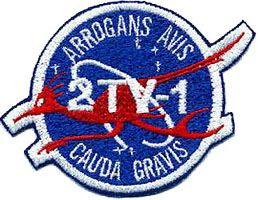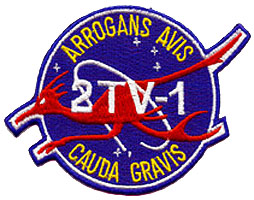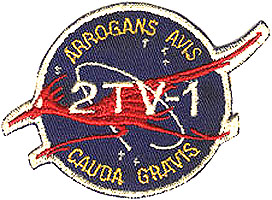
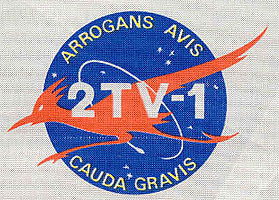


Before the first manned flights of the new and untried Apollo spacecraft, NASA wanted to simulate here on Earth as much of the Space enviroment as possible. This was required for both major Apollo components: the Command and Service Modules (CSM) as well as the Lunar Module (LM)
In the spring of 1968, two important tests called 2TV-1 and LTA-8 were performed in the Space Enviroment Simulation Laboratory (SESL) at the Manned Spacecraft Center in Houston, Texas. The SESL was a huge chamber capable of simulating the vacuum of space as well as the temperatures and lighting conditions that would be experienced during a space flight. In Chamber-A of the SESL the 2TV-1 test with the CSM took place, and Chamber-B focused on LTA-8.
The CSM test was scheduled to begin in February 1967 using Apollo spacecraft 2TV-1 (Block II Termal Vacuum no.1). However, following the January 1967 Apollo-1 fire, all vacuum chamber test were put on hold. As a result of the fire it was decided that all manned flights would be flown in Block II vehicles. The first manned Apollo mission, a CSM only flight named Apollo-7, would be lauched sometime during the third quarter of 1968. Except for some flight qualified equpment, 2TV-1 would be identical to CSM-101 (Apollo-7). A firm rule was established that the 2TV-1 test would be a constraining factor for that mission, it would have to be completed at least one month prior to Apollo-7 and would have to be successful or there would be no launch.
Delivery of the 2TV-1 spacecraft to MSC was planned for October 14, 1967. However, by August that date had slipped six weeks and it would keep slipping. Finaly on 11 March 1968 NAA (North American Aviation) completed assembly of CSM 2TV-1 and on April 9 it was shipped fro Downey to MSC where it was installed in chamber A of the SESL. After a dry run in June 1968, the crew was ready for the real thing. On Sunday June 16, 1968 they donned their spacesuits and entered the test chamber and the test began. Over the next week the crew went through the same sort of timeline that would be followed on a lunar mission. After spending 177 hours inside, the astronauts emerged from the chamber in excellent spirits on June 24. The critical 2TV-1 test had been a succes, clearing the way for Apollo-7.
The Artwork
The Crew
In August 1966 a review was held of the CSM-008 termal vacuum test. Deke Slayton, Director of Flight Crew Operations at MSC, proposed adding a flight surgeon to all future test crews to help define medical requirements and "to ensure adequate knowledge of crew members and test objectives for training and the real time mission". The only member of the astronaut corps with a medical background at the time was Joe Kerwin and he was chosen as a crew member for the next long-duration test. In early 1968 the crew for 2TV-1 was named and the commander would be Joe Kerwin, who had been involved in the vacuum chamber operations since 1966, and he was also a member of the CSM-008 test crew. Vance Brand was named Command Module Pilot (CMP), and Joe Engle would be Lunar Module Pilot (LMP). Both Brand and Engle had joined the astronaut corps in April 1966. To an outsider it must have seemed a little unusual that Joe Kerwin, who had been selected with the first group of scientist-astronauts in 1965, was named commander. In those days there were some astronauts who felt that their scientist-colleagues didn't have "the right stuff". While Brand and Engle did not belong to that group, Kerwin says that; "It must have rankled them both to be outranked by a stupid staff afficer, but they never showed it".
Spot the patch!!!
Left:Astronaut Vance Brand inside the 2TV-1 spacecaft wearing the 2TV-1 patch on his left chest.
Source / Availability
This is a very rare patch, but souvenir versions are available. Below you can see two souvenir version of the patch. The left patch was made by Don Simpson; the right patch by Randy Hunt.
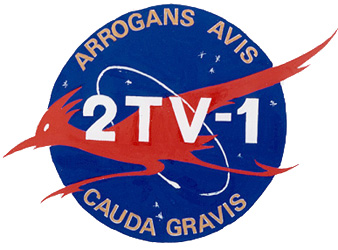
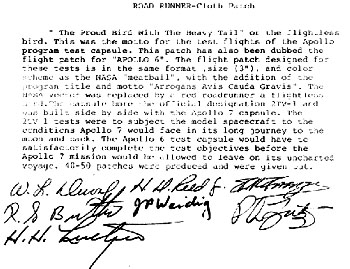
The crew had designed their own mission patch, wich was worn on their spacesuits during the test. It resembled the NASA "meatball" insignia, and featured a roadrunner as well as the Latin phrase "Arrogans Avis Cauda Gravis". The roadrunner was a Texan bird, perhaps best known as a cartoon character that was perpetually chased across the dessert by Wile E. Coyote. It was symbolic for the period 1967-68 during wich the pace of work at NASA was ver fast. More importantly: it didn't fly, making it a perfect symbol for 2TV-1. The Latin phrase was a reference to the slogan "The Proud Bird With The Golden Tail", that Continental Airlines used during those days to describe their fleet. "Arrogans Avis Cauda Gravis" means "The Proud Bird With The Heavy Tail", again emphasising that 2TV-1 was not going anywhere.
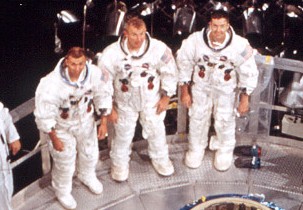
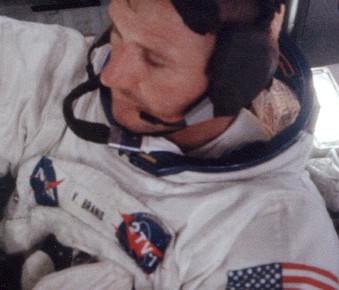
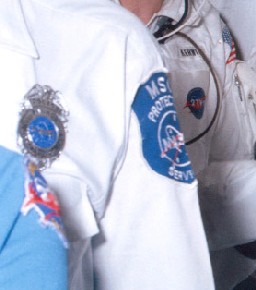
Right:Two versions of the patch. The beta cloth is on Joe Kerwins suit, the embroidered patch is on the arm of a suport person.
